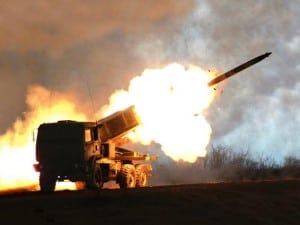The Army is expecting to save nearly $150 million if it’s able to award multi-year contracts in fiscal year 2024 for GMLRS and Patriot Advanced Capability (PAC)-3 missiles, according to newly released Pentagon documents.
The Pentagon’s comptroller’s office has detailed the Army’s multi-year procurement (MYP) requests for the two munitions, which include a potential four-year, nearly $2.6 billion deal for 18,000 GMLRS rockets and a three-year, $2.58 billion award for up to 1,000 PAC-3 Missile Segment Enhanced (MSE) missiles.

Photo: Lockheed Martin
Army Secretary Christine Wormuth confirmed earlier in March the service plans to seek congressional approval to award multi-year deals for the Lockheed Martin [LMT]-built GMLRS and PAC-3 MSEs in fiscal year 2024, citing cost savings and industrial base stability as key factors in the pitch to lawmakers (Defense Daily, March 16).
While Congress included a provision allowing multi-year deals for certain critical munitions in the latest defense policy bill, Army officials have noted the service will require specific approval language from the appropriations committees to enter into such deals above $500 million.
On GMLRS, the new document states the multi-year request would result in cost savings of $67.6 million, or 2.5 percent, compared to awarding contracts annually.
Awarding contracts annually from FY ‘24 to ‘27, the period covered by the multi-year deal, would be expected to total around $2.67 billion, according to the documents.
“Sufficient funding exists within current budget controls to execute this procurement plan,” the document states. “The Army has demonstrated its commitment to a stable funding stream for the GMLRS MYP through every step of this year’s budget process by fully funding the requirement. This commitment was reaffirmed by U.S. Army and DoD leadership through its support in the final budget submission.”
The GMLRS document cites reducing disruptions in vendor delivery and schedules as an additional benefit to the MYP procurement approach.
“The stability afforded by the use of a multiyear procurement will allow the prime contractor to enter into long term agreements with suppliers, at every tier, which provide substantial benefit. Such long term agreements incentivize both the prime and the subcontractors to invest in process improvements that yield long term benefits in terms of product quality and cost. The contractor and subcontractor will be at a reduced risk when implementing production process improvements, facility improvements, tooling design improvements, and fabrication process improvements,” the document states.
For PAC-3 MSEs, the document states awarding an MYP contract would lead to around $79.9 million, or just under three percent, in cost savings relative to awarding contracts annually over that same period.
Awarding annual deals for PAC-3 MSEs from FY ‘24 to ‘26, the period covered by the MYP request, would be expected to total $2.66 billion, according to the documents.
The MYP deal for PAC-3 MSEs, if approved, is expected to be awarded on Dec. 30 and would cover a minimum quantity of 692 missiles, with options for up to 1,000 missiles to cover supplemental U.S. and foreign military sale requirements.
“The PAC-3 MSE [is] a key enabler of the Army Modernization Priorities in support of Air and Missile Defense and the funding line is approved through the current Future Year Defense Program. The minimum need for the PAC-3 MSE is not expected to decrease during the contemplated contract period, and there are high demand signals for the PAC-3 MSE for both the U.S. and our FMS partners,” the document states.
The comptroller’s document states the MYP strategy for PAC-3 MSEs “reduces the risk of delayed deliveries through the advance procurement of long lead items.”
“Cost savings resulting from economic order quantities and independent planning may result in benefit to industry and government,” the document states.